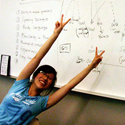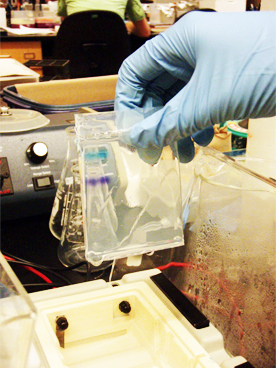Team:British Columbia/Notebook/Week 3
From 2011.igem.org
(→June 19 2011) |
|||
| Line 2: | Line 2: | ||
==June 19 2011== | ==June 19 2011== | ||
| + | [[File:ubcjun19gel.jpg]] | ||
'''3-Carene''' | '''3-Carene''' | ||
Revision as of 21:12, 3 August 2011

 |
 |
 |
 |
 |
Contents |
June 19 2011
3-Carene
Daisy did a DpnI digest of her multiple site-directed mutagenesis product and ran it on a gel. The appropriate sizes were shown on the gel, running at 7.6 kb. Daisy transformed the products into Dh5 alpha cells.
June 20 2011
Gurpal gave a modeling presentation - indicating the parameters that are needed, and how the wetlab will be incorporated into the model.
Laura contacted Science World (for human practices), and we will be doing a presentation and workshop on synthetic biology. This still needs to be planned.
Joe's started his SDM on alpha-pinene, but it hasn't been working. He's been troubleshooting (DNA contamination? Enzyme is too old? Wrong annealing temperature?)
The team agrees that the amount of e-mails is ridiculous; everyone is getting lost! Laura volunteers to develop e-mail lingo to organize the e-mails and to help direct e-mail traffic to the appropriate people.
June 21 2011
3-Carene
Daisy picked several colonies to screen for the mutations. She picked several colonies and inoculated them in LB culture for overnight growth.
1,8-Cineole
Jacob began SDM-PCR to remove PST1 site.
June 22 2011
Our group was low on competent cells so making more of them was a priority this week. Rafael started the protocol by putting 10mL of an overnight culture in an incubator. The cells were DH5(alpha) cells.
1,8-Cineole
Jacob tested yesterday's SDM-PCR product with gel electrophoresis.
June 23 2011
The next day, Gurpal took charge of making competent cells. It was his first time making competent cells (and performing his own iGEM laboratory work for the first time) and he knew the group needed them - the pressure was on. Gurpal made and autoclaved 1L of LB broth while filter sterilizing 0.1M CaCl2. Then, he grew the overnight culture, in LB broth, in a 30 degree Celsius incubator until a spectrophotomter reading of Abs600nm = 0.401 was achieved. It took about 1.5 hours to reach this point. Next the mixture was spun down using a centrifuge and the supernatant was removed. Next, the pellet was washed in CaCl2 and spun down again. After the cells were kept on ice for 40 minutes, they were spun down again, the supernatant was removed and then Gurpal stored them at 4 degrees Celsius overnight. The next day, on June 24, Laura and Gurpal started an assembly line and stored over 120 aliquots of competent cells in glycerol solutions. The cells were finally stored in a -80 degrees Celsius freezer for later use.
Sam and Gurpal made LB agar plates with ampicillin. First, Gurpal prepared a stock ampicillin solution of 100 mg/mL. He added ethanol to the solution so that the ampicillin would not freeze in the -20 degree freezer - so it could be used immediately during an experiment. Next, Sam made LB agar and autoclaved it. When the LB agar cooled down a bit, we added ampicillin into the LB agar and poured ~16 plates.
In order to check that the plates were working, Sam and Gurpal transformed ampicillin resistant plasmids into ecoli. They had a positive control, a negative control and their sample. They grew the ecoli overnight in a 37 degree incubator.
3-Carene
Daisy miniprepped the plasmids.
June 25 2011
Gurpal and Sam validated their competent cells by looking at transformation efficiency.
 "
"















